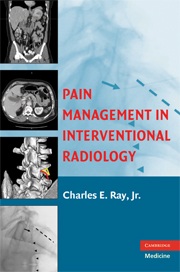Book contents
- Frontmatter
- Contents
- Contributors
- Preface
- Acknowledgments
- 1 Pain Management in Interventional Radiology: An Introduction
- 2 Clinical Evaluation of Low-Back Pain
- PART I LOCOREGIONAL PAIN CONTROL
- 3 Local Anesthetics
- 4 Functional Lumbar Spine Anatomy: A Review
- 5 Percutaneous Vertebroplasty
- 6 Kyphoplasty
- 7 Epidural Steroid Injections
- 8 Selective Nerve Root Blocks
- 9 Discography
- 10 Facet (Zygapophyseal) Joint Injections
- 11 Articular Interventions in Pain Management: A General Approach
- 12 Percutaneous Management of Visceral Pain
- 13 Embolization of Painful Neoplasms
- 14 Image-Guided Ablation of Painful Osteolyses
- 15 Chronic Pelvic Pain in Women
- PART II SYSTEMIC PAIN CONTROL
- Index
- References
11 - Articular Interventions in Pain Management: A General Approach
from PART I - LOCOREGIONAL PAIN CONTROL
Published online by Cambridge University Press: 04 September 2009
- Frontmatter
- Contents
- Contributors
- Preface
- Acknowledgments
- 1 Pain Management in Interventional Radiology: An Introduction
- 2 Clinical Evaluation of Low-Back Pain
- PART I LOCOREGIONAL PAIN CONTROL
- 3 Local Anesthetics
- 4 Functional Lumbar Spine Anatomy: A Review
- 5 Percutaneous Vertebroplasty
- 6 Kyphoplasty
- 7 Epidural Steroid Injections
- 8 Selective Nerve Root Blocks
- 9 Discography
- 10 Facet (Zygapophyseal) Joint Injections
- 11 Articular Interventions in Pain Management: A General Approach
- 12 Percutaneous Management of Visceral Pain
- 13 Embolization of Painful Neoplasms
- 14 Image-Guided Ablation of Painful Osteolyses
- 15 Chronic Pelvic Pain in Women
- PART II SYSTEMIC PAIN CONTROL
- Index
- References
Summary
INTRODUCTION
In the early 16th century, Paracelsus described the joint as a fluid-filled space. However, it was not until the early 20th century that aspiration and injection of the joint for the treatment of maladies was attempted. Today, articular injections are a common outpatient procedure (1). However, in contrast to the common and well-accepted articular interventions performed, the data supporting such interventions are sparse. In general, most intraarticular interventional research is performed on the knee and then extrapolated to other joints. Additionally, most research is focused on the treatment of osteoarthritis pain and then extrapolated to other disease processes, such as rheumatoid arthritis, crystal deposition disease, athletic injuries, and other arthropathies. A further confounding factor in interpretation of the literature on articular interventions is that there is a profound placebo effect (2), a complicating factor that accompanies interpretation of procedure outcomes.
Inherent in any study involving pain is the general difficulty in quantifying what is generally a very subjective outcome. Many different markers have been used in an attempt to quantify outcomes such as pain scales, range of motion, and time performing a given exercise. All are imperfect and add an additional level of complexity. Finally, and perhaps most importantly from an interventional radiology standpoint, few studies verify needle or agent location. This creates considerable confusion when interpreting the literature and exploring patient outcomes involving articular/periarticular interventions. In some cases, a significant percentage of interventions are performed and evaluated in a nontarget or inconsistent location.
- Type
- Chapter
- Information
- Pain Management in Interventional Radiology , pp. 164 - 187Publisher: Cambridge University PressPrint publication year: 2008

